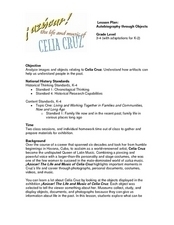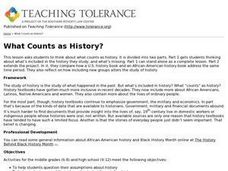Curated OER
Evolution of Mass Media after 1920
Eleventh graders study the importance of media through American History. In this American History lesson plan, 11th graders develop teamwork skills discovering information regarding an assigned time period. Students predict and analyze...
Curated OER
Political Cartoons
Students analyze cartoons by identifying the symbols, characters and information and its significance in history. They examine the economic and political changes in contemporary America. They determine that political cartoons play an...
Curated OER
Virginia's Historical Figures
Fourth graders write full paragraphs about important historical figures from Virginia's history. They research an the historical figure before word processing three complete paragraphs using facts and appropriate clipart. They compare...
Curated OER
Ben Franklin
Students study Ben Franklin and why he was an important person in our country's development. They draw a picture of him by following step by step oral instructions.
Curated OER
Postcards in Time
Middle schoolers write and send postcards to and from famous historical figures.
Curated OER
Painted Lodges
Students explore lodge construction as a representation of culture. In this cultural diversity and Native American history lesson, students listen to a narrative explaining the origin of Native American painted lodges. Students design...
Curated OER
A Visit to China
Sixth graders study the history of China. They explore the Chinese people, the Great Wall of China, religions, government and Dynasties. In groups, 6th graders collect information on China. They write a report on their findings and...
Curated OER
From The Great War To The Great Depression
Discover details about 1920's America. In this American history lesson, students read From the Great War to the Great Depression. Students then research famous Americans from the time period and present their findings to their classmates.
Stanford University
Buddhist Monk Protest
What makes the Buddhist Monk Protest a historically significant event? Interested historians use photographic evidence and source information to analyze and explain the importance of the event. The assessment is structured in a short...
Jersey Heritage
A Victorian Christmas
In many ways, Victorian Christmas is alive and well today! Class members read an informative passage to learn more about traditional Christmas gifts, decorations, crackers, and visits from Santa Claus in nineteenth-century England—as...
Curated OER
Persuasive Journal Prompts
Need a journal topic? Whether you use these prompts as part of a persuasive writing unit, or reproduce the download as a one-page handout for your class members, the suggested topics make a great addition to your curriculum library. In...
Curated OER
A Day of Infamy:Analyzing FDR’s Pearl Harbor Address
In 1941 FDR spoke out on the events at Pearl Harbor. The class will get to analyze word choice, word meaning, author's craft and structure by analyzing an actual draft of this speech. They will look critically at the words used,...
Curated OER
Introduction to Abigail Adams
Remember this lady! Abigail Adams, the wife of John Adams, the second President of the United States, and the mother of the sixth president, John Quincy Adams, was much more than a wife and mother. This prolific letter writer is the...
Curated OER
Immigration
This 3-day immigration study draws on historical trends and current events. A worksheet accompanies initial research on one group's U.S. immigration history, giving opportunity for collaborative learning through sharing findings. Groups...
Museum of Disability
Taking Visual Impairment to School
What is the world like when you can't see, or when your vision is impaired? Learn about how Lisa communicates with the world around her with Taking Visual Impairment to School by Rita Whitman Steingold. Learners answer discussion...
Smithsonian Institution
Autobiography through Objects
Show youngsters how objects can tell a story! Here your class will learn about Cuban salsa dancer Celia Cruz by analyzing pictures of her dress, her shoes, and her marriage certificate. After describing Cruz's items and imagining what...
Curated OER
Compare and Contrast Timelines of the World
Seventh graders create a classroom timeline of important world events. This instructional activity is meant to be used during the entire school year. As the school year goes along, events are added to the timeline as chosen by the class....
Curated OER
What Counts as History?
Eighth graders explore the question "What Counts as History?" For this Philosophy lesson, 8th graders pretend that they are going to interview a historian. Students read a primary source and answer the questions that follow.
Curated OER
Life in Britain during the Industrial Revolution
Young scholars comprehend the living conditions, experiences and opinions of the people who lived during the Industrial Revolution. They examine primary source documents relevant to the topic. Students compose a letter representing the...
Curated OER
Power to the People
Students work together to research leaders of disadvantaged groups. They identify how these people use the nonprofit sector to make positive changes. They discuss how the leader uses the democratic core values and present the information...
Curated OER
Culture Collage
Young scholars investigate their cultural heritage and make observations on how much influence their past has on their current values and lifestyle. They brainstorm a list of things that represent a certain country or cultural heritage...
National Endowment for the Humanities
The Greek Alphabet: More Familiar Than You Think!
In this Greek alphabet lesson, pupils explore the Phoenician origins to the Greek alphabet. Learners compare Greek letters to current letters and write a paragraph about the life of young scholars in ancient Greece. They also identify...
Curated OER
What's in a Name? The Use of Native American Images in Sports
Students discuss and analyze the pros and cons of using Native American names and images to represent sports teams. Using primary sources, including position statements from Native American tribes, interviews with school alumni and...
Curated OER
Activism and Social Reform in America from 1800-1850
Learners discuss idea of social status, examine antebellum social reform movements, and compare and contrast experiences of activists who sought to improve workers' lives, end slavery, reform immigration laws, and establish voting rights...

























